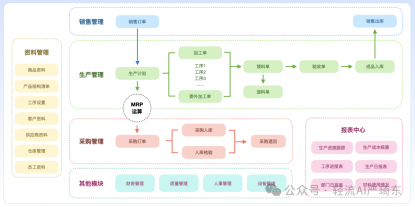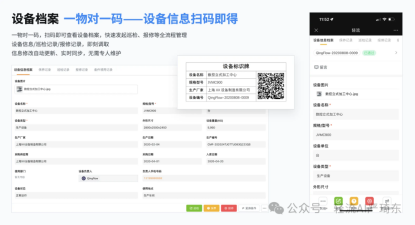A. Overall Description of Pain Points in Production Planning and Equipment Management
In the landscape of enterprise production management, businesses frequently encounter a series of obstacles in production planning and equipment management. These challenges not only impede operational efficiency but also erode profitability.
- Inefficient Production Planning: Many enterprises struggle to create accurate production plans. This is due to factors such as inaccurate demand forecasting, lack of real - time data on inventory and capacity, and difficulties in coordinating across different departments. As a result, production schedules can be disrupted, leading to delays and increased costs.
- Poor Equipment Maintenance: Equipment breakdowns can bring production to a halt. Traditional equipment maintenance approaches are often reactive, rather than proactive. This means that problems are only addressed after they occur, causing significant downtime and repair costs.
- Lack of Integration between Planning and Equipment Management: In many companies, production planning and equipment management operate in silos. There is a lack of communication and data sharing between these two crucial functions, leading to sub - optimal decision - making.
These pain points collectively create a complex web of issues that hinder the smooth operation of enterprises. Without effective solutions, businesses may find themselves at a competitive disadvantage in the market.
B. Case Analysis of Pain Points
1. Inefficient Production Planning
Inefficient production planning can have a domino effect on an enterprise's operations. When production plans are inaccurate, it can lead to overstocking or understocking of products. Overstocking ties up capital in inventory, while understocking can result in lost sales opportunities. For example, consider a manufacturing company that produces consumer electronics. If the production plan does not accurately account for seasonal fluctuations in demand, the company may end up with excess inventory during slow seasons or face shortages during peak seasons. In the case of Shanti Electric, due to the industry - specific nature of having "complete sets of accessories" in sales orders, where one product contains multiple types of material accessories, traditional production planning methods were insufficient. The company had to manually "break down" and "sort" orders to identify the types and quantities of materials. This manual process was time - consuming and error - prone, often leading to production waste and inaccurate scheduling.
2. Poor Equipment Maintenance
Poor equipment maintenance is a major headache for enterprises. When equipment breaks down unexpectedly, it can cause significant disruptions to the production process. For instance, in a textile factory, a malfunctioning spinning machine can halt the entire production line, leading to delays in fulfilling orders. In the past, many enterprises lacked a systematic approach to equipment maintenance. They relied on periodic inspections, which may not be sufficient to detect potential problems in a timely manner. As a result, equipment failures often occurred at the most inconvenient times, causing costly repairs and lost production time. A textile enterprise, for example, previously had no in - depth analysis of equipment operation data. They were unable to accurately assess the impact of equipment on production efficiency. This led to sub - optimal equipment usage and maintenance strategies, resulting in lower production efficiency.
3. Lack of Integration between Planning and Equipment Management
The lack of integration between production planning and equipment management can lead to missed opportunities for optimization. For example, if the production plan does not take into account the availability and capacity of equipment, it may schedule production tasks that the equipment cannot handle. This can lead to over - utilization of some equipment, increasing the risk of breakdowns, while other equipment may be under - utilized. In a manufacturing plant that produces automotive parts, if the production planning department is not aware of the maintenance schedule of a key piece of equipment, they may schedule production tasks during the maintenance period, causing unnecessary delays.
C. Product Introduction
1. Traditional ERP Software
Traditional ERP software has long been used in enterprise management. It offers a range of functions, including inventory management, order processing, and financial management. In the context of production planning and equipment management, ERP systems can provide some level of support. For example, they can help track inventory levels and generate basic production schedules. However, traditional ERP software has its limitations. It often lacks the flexibility to adapt to the specific needs of different industries and enterprises. In addition, its material coding capabilities are relatively weak, usually relying on manual input rather than automatic generation. This can lead to inefficiencies and errors in production planning.
2. Specialized Equipment Management Software
Specialized equipment management software focuses on the maintenance and monitoring of equipment. It can help enterprises schedule preventive maintenance, track equipment history, and manage spare parts inventory. By using this software, enterprises can reduce the risk of equipment breakdowns and extend the lifespan of their equipment. However, this type of software may not be fully integrated with production planning systems. As a result, it may not be able to provide comprehensive solutions that consider both production requirements and equipment availability.
3. No - code Platform: Wingent
Wingent is a no - code platform that can effectively address the pain points in enterprise production planning and equipment management. It offers a range of features that can streamline operations and improve efficiency.
D. How Wingent Solves the Pain Points in Production Planning and Equipment Management
Wingent is a powerful no - code platform that offers comprehensive solutions to the pain points in production planning and equipment management.
1. Precise Production Planning
Wingent enables enterprises to create accurate production plans. It can integrate data from various sources, such as sales orders, inventory levels, and production capacity, to generate real - time and accurate production schedules. For example, in the case of Shanti Electric, Wingent's "data association" and "association with existing data" functions were used to automatically generate material codes. This eliminated the need for manual coding, reducing errors and saving time. When a sales order comes in, Wingent can automatically analyze the order, break it down into its component parts, and calculate the required materials and production quantities. This ensures that production plans are based on accurate data, reducing waste and improving efficiency.

2. Proactive Equipment Maintenance
Wingent helps enterprises transition from reactive to proactive equipment maintenance. It can monitor equipment in real - time, collecting data on parameters such as temperature, vibration, and usage. By analyzing this data, Wingent can predict potential equipment failures and schedule preventive maintenance in advance. For example, in a manufacturing plant, Wingent can detect early signs of wear and tear on a machine and prompt the maintenance team to perform maintenance before a breakdown occurs. This reduces downtime and repair costs. A textile enterprise using Wingent was able to improve its production efficiency by 40% through data - driven efficiency analysis. The system presented the analysis results in an intuitive way, such as an equipment health heat map, allowing the enterprise to clearly understand the operating efficiency of each piece of equipment and optimize its usage and maintenance strategies accordingly.

3. Seamless Integration between Planning and Equipment Management
Wingent breaks down the silos between production planning and equipment management. It allows for seamless data sharing and communication between these two functions. For example, when a production plan is updated, Wingent can automatically check the availability of equipment and adjust the plan if necessary. This ensures that production plans are realistic and achievable, taking into account the actual state of the equipment. In a company that produces industrial machinery, Wingent enables the production planning department to have real - time access to equipment maintenance schedules and status, allowing for better coordination and decision - making.

4. Employee Skill Enhancement
Wingent also provides support for employee skill development. It offers an online skills training platform that allows employees to learn at their own pace. For example, daily pre - shift meeting demonstration videos can be recorded and made available for employees to watch at any time. Through an employee skills assessment software, the system can record employees' skill improvement, helping enterprises improve the overall skill level of their workforce. This is crucial for ensuring that employees can operate equipment effectively and follow production plans accurately.

5. Standardized Production Processes
Wingent helps enterprises establish standardized production processes. It can present production operation processes in the form of pictures, texts, and videos. Employees can refer to these materials at any time during operation, ensuring the standardization of production operations. In addition, it can formulate contingency plans for abnormal situations, such as sudden orders. When such situations occur, the system can adjust the production schedule flexibly based on capacity and inventory data, ensuring the smooth progress of production.

6. Equipment File Management
Wingent enables enterprises to establish detailed equipment files. By generating a unique QR code or barcode for each piece of equipment, all relevant information can be stored in the file, including basic purchase information such as model, specifications, supplier, and price, as well as acceptance reports and user manuals. This makes every stage of equipment management traceable, standardizing the entire equipment life - cycle management process.

In summary, Wingent effectively addresses the pain points in enterprise production planning and equipment management. It provides a comprehensive solution that integrates various aspects of production management, from planning to equipment maintenance, and from employee training to process standardization.
In conclusion, the challenges in enterprise production planning and equipment management are significant, but with the right tools, they can be overcome. Wingent offers a powerful and flexible solution that can help enterprises streamline their operations, improve efficiency, and gain a competitive edge in the market. By addressing issues such as inefficient planning, poor equipment maintenance, and lack of integration, Wingent enables enterprises to optimize their production processes and achieve better business results. Reference:
[1] 7大维度,中小制造业企业如何选择生产管理系统? https://mp.weixin.qq.com/s/pm14LCcwxlHfMKRHAgkEFQ
[2] 生产设备管理:一全、二实、三预、四驱、五联 https://mp.weixin.qq.com/s/slh_SRaDdwl07yYTLHcPUg
[3] 安全生产管理的 一核、二防、三查、四管、五素 https://mp.weixin.qq.com/s/Bw7o19jS_NqVrTLxZ2FVug
[4] 生产计划、排产调度、现场管控、质量管理怎么做?一文看懂生产全流程管理 https://mp.weixin.qq.com/s/DR2qqMLPuA4ADOOJvtuLPw
[5] 3000字把怎么做设备档案、巡检、报修、保养讲清楚了 https://mp.weixin.qq.com/s/uxhoGdjN9JrN3XGpw6XDMA